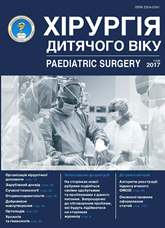A classification algorithm for treatment of children with haemangiomas located on external covering
DOI:
https://doi.org/10.15574/PS.2017.54.52Keywords:
children, haemangioma, treatmentAbstract
Purpose – improving the results and efficacy of treatment of children with haemangiomas (HA) located on external covering by applying a classification algorithm.
Material and methods. The clinical retrospective study of children with HA located on external (skin and/or mucosa) covering for the past 10 years was conducted in Podolsk region of Ukraine. The study included an analysis of patient case histories and outpatient case records of children who were hospitalized or underwent outpatient treatment during the period from 2002 to April 2012 with the diagnosis «Haemangioma of external covering».
Results. The applying of the classification algorithm in treatment of children with HA located on external covering permitted to achieve good and satisfactory oncological, functional and cosmetic outcomes in 97% of observations.
Conclusions. The choice of disease management in children with HA located on external covering should be individualized, excluding unreasonable expectant approach of a possible tumor regression. Choice of treatment modality in children with HA located on external covering should be based on the classification algorithm according to its morphological characteristics.
References
Bogomolets OV. 2001. Podhodyi k lecheniyu bolnyih s ploskimi gemangiomami. Dermatologiya ta venerologiya. 1: 58–61.
Butorina AV, Shafranov VV. 1999. Sovremennoe lechenie gemangiom u detey. Lechaschiy vrach. 5: 61–64.
Nikitin AA. 1999. Analiz rezultatov nekotoryih metodov lecheniya gemangiom u detey. Problemyi stomatologii i neyrostomatol. 3: 18–21.
Paschenko YuV, Vivcharuk VP, Paschenko KYu. 2011. Gemangiomyi u detey: sovremennyie tendentsii i perspektivnyie napravleniya lecheniya. Meditsina neotlozhnyih sostoyaniy. 6: 84–88.
Ryibalov OV, Sayapina LM. 2000. Opyit kombinirovannogo lecheniya bolnogo kaverznoy gemangiomoy verhney gubyi. Stomatologiya. 79; 12: 22–24.
Fomina LV. 2001.Vliyanie ekstrakletochnogo matriksa na razvitie kapillyarov gemangIom. VIsnik morfologiyi. 7; 2: 301–304.
Harkov LV, Kolesnikova NA, Nerodenko NI. 2003. Kliniko-morfologicheskaya harakteristika rastuschih gemangiom u detey mladshego vozrasta. VIsnik stomatol. 1: 47–50.
Shapkin VV, Melnikov AV, Pilipenko AP. 2004. Taktika pri gemangiomah u detey: esteticheskie i prakticheskie voprosyi. Pacific Medical Journal. 2: 35–36.
Shafranov VV. 2004. Primenenie metoda SVCh-destruktsii dlya lecheniya gemangiom u detey (kliniko-eksperimentalnoe issledovanie). Detskaya hIrurgIya. 1: 37–41.
Shcherbak YuO. 2004. Hemanhiomy shkiry yak skladova chastyna syndromalnoho diahnozu. Pediatriia. 67; 5: 831–833.
Very M, Nagy M, Carr M, Collins S. 2002. Hemangiomas and vascular malformations: analysis of diagnostic accuracy. Laryngoscope. 112; 4: 612–615. https://doi.org/10.1097/00005537-200204000-00004; PMid:12150511
Hunt SJ, Barnhill RL. 2004. Vascular tumors. Textbook of Dermatopathology. 2nd Ed. New York: McGraw-Hill: 821-870.
Pagliai KA, Cohen BA. 2004. Pyogenic granuloma in children. Pediatr Dermatol. 21; 1: 10–13. https://doi.org/10.1111/j.0736-8046.2004.21102.x; PMid:14871318
Pascual-Castroviejo S, Pascual-Pascual J. 2007. Facial Hemangioma and Hemispheric Migration Disorder: Presentation of 5 Patients. Am J Neuroradiol. 37; 34: 1609–1612. https://doi.org/10.3174/ajnr.A0583; PMid:17846222
Puxeddu R, Berlucchi M, Farina D. 2006. Lobular capillary hemangioma of the nasal cavity: a retrospective study on 40 patients. Am J Rhino. 20; 4: 480–484. https://doi.org/10.2500/ajr.2006.20.2878; PMid:16955784
Downloads
Issue
Section
License
The policy of the Journal “PAEDIATRIC SURGERY. UKRAINE” is compatible with the vast majority of funders' of open access and self-archiving policies. The journal provides immediate open access route being convinced that everyone – not only scientists - can benefit from research results, and publishes articles exclusively under open access distribution, with a Creative Commons Attribution-Noncommercial 4.0 international license(СС BY-NC).
Authors transfer the copyright to the Journal “PAEDIATRIC SURGERY.UKRAINE” when the manuscript is accepted for publication. Authors declare that this manuscript has not been published nor is under simultaneous consideration for publication elsewhere. After publication, the articles become freely available on-line to the public.
Readers have the right to use, distribute, and reproduce articles in any medium, provided the articles and the journal are properly cited.
The use of published materials for commercial purposes is strongly prohibited.

